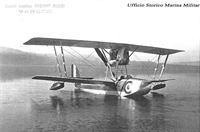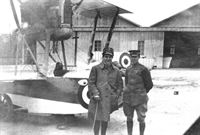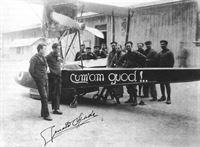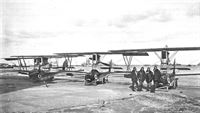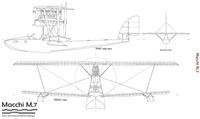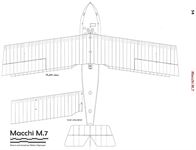А.Шепс Самолеты Первой мировой войны. Страны Антанты
Летающая лодка-истребитель М.7 стала развитием самолета М.5, но для увеличения скорости и улучшения маневренности в ее конструкцию были внесены значительные изменения. Как и последние самолеты М.5, новая машина оснащалась двигателем "Изота-Фраскини" V-6B (250 л. с.). Однако самолет имел новую конструкцию лодки. Она получила слабокилеватый редан и приподнятую хвостовую балку. Верхнее крыло стало почти на 2 м короче. Хорда крыльев, особенно нижнего, была значительно увеличена. Это позволило, сохранив ту же несущую поверхность, улучшить маневренность машины. Подкрыльевые поплавки, в отличие от М.5 (имевшей поплавки, выполненные заподлицо с крылом), устанавливались на коротких стойках. Удачная машина была пущена в серию, но принять участие в боевых действиях ей практически не пришлось - война закончилась.
Модификации
М.7 - серийная машина с двигателем "Изота-Фраскини" V-6B (250л. с.).
М.7 bis - развитие М.7 с двигателем "Изота-Фраскини" (300 л. с.).
М.7 ter и ter AR - установлен более мощный двигатель "Лоррен-Дитрих" (400л. с.).
М.7 ter В - развитие предыдущего самолета с двигателем "Лоррен-Дитрих" (480 л. с.).
Показатель Макки М.7 1918г. Макки М.7 ter 1920г.
Размеры, м:
длина 8,10 8,10
размах крыльев 9,95/8,30 9,95/8,30
высота 2,95 2,95
Площадь крыла, м2 26,40 26,40
Вес, кг:
максимальный взлетный 1080 1100
пустого 775 800
Двигатель: "Изота-Фраскини" V-6B "Лоррен-Дитрих"
мощность, л. с. 250 400
Скорость, км/ч 211 200
Дальность полета, км 840 700
Потолок практический, м 5000 6500
Экипаж, чел. 1 1
Вооружение 2 пулемета 2 пулемета
Показать полностью
Jane's All The World Aircraft 1919
MACCHI "7"
Type of machine Single-seater Waterplane.
Name or type No. of machine M7.
Purpose for which Intended Hunter.
Span 9.95 m.
Gap 1.96 m.
Overall length 8.10 m.
Maximum height ?. 2.95 m.
Chord Upper wing, 1.670 m.;
Lower wing, 1.31 m.
Total surface of wings 26.6 sq. m.
Span of tall 2.84 m.
Total area of tail 2.65 sq. m.
Elevator, maximum 2.84 x 0.6 m.
Rudder, maximum 1.12 x 0.6 m.
Fin, maximum 2.50 x 0.55. m
Ailerons 2.70 sq. m.
Fuselage dimensions, horizontal 1.15 m.
Fuselage dimensions, vertical 0.90 m.
Engine type and h.p. Isotta Fraschini V6. 260 h.p.
Airscrew, diam. and revs. 2.55 m., 1800.
Weight of machine empty 775 kgs.
Load per sq. m. 41.5 kilos.
Weight per h.p. 4.325 kilos.
Tank capacity In hours 4 hours.
Performance.
Speed low down 210 k.p.h.
Climb.
To 6,000 metres in minutes 21 mins.
Total useful load 305 kilos.
Total weight of machine fully loaded
1.080 kgs.
Показать полностью
W.Green, G.Swanborough The Complete Book of Fighters
MACCHI M.7 Italy
The M.7 was essentially a progressive development of the M.5 and entered flight testing early in 1918. Powered by a 247 bhp Isotta-Fraschini V.6 engine, the M.7 was of wooden construction similar to that of its predecessors and carried an armament of twin 7,7-mm Vickers guns. It featured a simplified wing cellule, with paired, splayed interplane struts. Series production was initiated, but orders were curtailed with the end of hostilities, 11 being completed of which three were delivered before the end of World War I. Two each were purchased by Argentina and Sweden in 1919, and three were procured by Brazil in 1921. Despite the cancellation of orders for the Regia Marina, development of the basic design continued, one example being fitted with a hull of increased fineness ratio, and two were modified to M.7 bis standard for participation in the 1921 Schneider Trophy contest. The M.7 bis had wing span and area reduced to 25 ft 5 in (7,75 m) and 256.19 sq ft (23,80 m2) respectively, and captured the Trophy in August 1921 with an average speed of 117.75 mph (189,50 km/h) in a contest in which the Macchi 'boat was, in fact, the only participant.
Max speed, 130 mph (210 km/h).
Time to 16,405 ft (5000 m), 23 min.
Endurance, 3.66 hrs.
Empty weight, 1,708 lb (775 kg).
Loaded weight, 2,381 lb (1080 kg).
Span, 32 ft 7 3/4 in (9,95 m).
Length, 26 ft 6 9/10 in (8,10 m).
Height, 9 ft 8 1/8 in (2,95 m).
Wing area, 286.33 sq ft (26,60 m2).
MACCHI M.7TER Italy
Only nominally a development of the wartime M.7 fighter, the M.7 ter, flown as a prototype in October 1923, was virtually a new design, with a redesigned hull, a revised and lighter structure and wings of revised planform and reduced area. Primarily of wooden construction, with a 247 bhp Isotta-Fraschini V.6 engine and twin-Vickers gun armament, the M.7 ter was ordered into series production to re-equip the Squadriglie Caccia Marittima as the M.7terA, the M.7terAR having folding wings for operation from the seaplane carrier Miraglia. The M.7terB was powered by a 480 hp Lorraine 12Db engine, and, in 1927, the Societa Aeronautica Italiana re-engined 14 M.7terA 'boats with the 250 hp Isotta-Fraschini Semi-Asso engine. Total production of the M.7 ter exceeded 100 machines and these equipped all six Squadriglie Caccia Marittima by 1925 at the principal Italian naval bases, these eventually forming the 80° Gruppo. Eighty-three were in service in 1927, including 29 of the folding-wing AR version, the last being withdrawn from first line service in 1930.
Max speed, 129 mph (208 km/h).
Time to 3,280 ft (1000 m), 2.75 min.
Endurance, 3 hrs.
Empty weight, 1,775 lb (805 kg).
Loaded weight, 2,381 lb (1 080 kg).
Span, 32 ft 7 3/4 in (9,95 m).
Length, 29 ft 0 1/3 in (8,85 m).
Height, 9 ft 8 9/10 in (2,97 m).
Wing area, 252.96 sqft (23,50 m2).
Показать полностью
D.James Schneider Trophy Aircraft 1913-1931 (Putnam)
Macchi M.7
The Societa Anonima Nieuport-Macchi, formed by Giulio Macchi in 1912 at Varese, a small Italian town near the Swiss border, undertook the manufacture of Nieuport designs until 1919 when its own designs of landplanes began to enter production. The Macchi flying-boat and seaplane tradition began in a curious manner during hostilities between Italy and Austria in 1915. When the Austrian Lohner L.I flying-boat L.40 was forced down, virtually undamaged, on the water near Porto Corsini seaplane base at Rimini, it was immediately taken to Varese, and Macchi was instructed to build a copy. The Macchi L.1 was in the air for the first time only a little over a month later, and it formed the basis of a number of successful Macchi flying-boats, among them the M.5 single-seat fighter design of Felice Buzio.
An experimental single-seater, the M.6, led on to the M.7, which was the first design of Alessandro Tonini, the Macchi company’s chief engineer. Powered by a 260 hp Isotta-Fraschini six-cylinder water-cooled inline engine, it had a maximum speed of about 210 km/h (130 mph). While the earlier Macchi fighter flying-boat designs had incorporated vee interplane struts, inherited from the classic Nieuport biplane fighters, the M.7 had the more conventional paired interplane struts and a wingspan reduced to 11-88m (39ft).
The slim, single-step, rectangular-section hull was built up from an ash framework with a spruce skin, the fin being built integral with the hull. The slightly swept unequal-span, single-bay, unstaggered biplane mainplanes of markedly curved aerofoil section had ash spars with spruce ribs, all fabric covered. The upper centre section above the engine was supported on wooden N-struts. Ailerons were carried only on the upper mainplane and were mounted at the extreme tips. The pairs of interplane struts were splayed out at the top when viewed both from front and sides, and the whole structure was braced by the conventional wires. The engine was carried above the hull on a pair of N-struts which also supported the upper centre-section struts. It was uncowled, with a large radiator mounted directly in front of the two banks of cylinders, and a smaller oil cooler was in a bulged fairing beneath the radiator. The tail unit consisted of a fabric-covered wooden-structured tailplane which was carried half-way up the quite tall and narrow-chord fin and was strut-braced to the hull. The rudder was only a little more than half the height of the fin and extended very little below the tailplane. Two square-section stabilizing floats were carried on struts under the lower wing. The open cockpit was directly below the water radiator, was protected by a small curved windscreen, and had a faired headrest for the pilot.
Determined to win the 1921 Schneider Trophy contest in Venice, and to take another step toward permanent possession of it, Italy gathered sixteen flying-boats for a series of national elimination trials to select a team. Among them were five M.7s flown variously by de Briganti, Buonsembiante, Corgnolino, Falaschi and de Sio, and with varying fortunes. De Briganti and Corgnolino won places in the Italian team, the M.7s of Buonsembiante and de Sio were withdrawn from the trials, and Falaschi crashed before they got under way.
Having won the 1921 contest, largely through the failure of the other entries either before or during the event, an M.7bis, I-BAFV, was entered for the 1922 contest when one of the selected team aircraft, the Savoia S.50, crashed. It took fourth, and last, place at an average speed of 199-607km/h (124-029mph).
Production of later versions of this tough little flying-boat fighter continued almost throughout the 1920s. One variant, the M.7ter, equipped all of the Italian squadriglie di caccia marittima (seaplane fighter squadrons) until 1929, with 163 Squadriglia retaining its M.7s for a further year.
Single-seat racing biplane flying-boat. Wood construction with wood skinning and fabric covering. Pilot in open cockpit.
One 260 hp Isotta-Fraschini Semi-Asso six-cylinder water-cooled inline engine driving a 2-2 m (7 ft 3 in) diameter two-blade wooden pusher propeller. The 1922 variant had a four-blade propeller.
Span 9-95m (32ft 8 in); length 8-13m (26ft 61 in); height 2-97m (9ft 9in); wing area 23-8sqm (256-18sqft).
Empty weight 780kg (1,719lb); loaded weight 1,080kg (2,381lb); wing loading 45-37 kg/sqm (9-29 Ib/sq ft).
Maximum speed 209km/h (130mph); stalling speed 100km/h (62mph).
Production - five refined versions of the Macchi M.7 military flying-boat were prepared for the 1921 Schneider Trophy contest by Societa Anonima Macchi at Varese. At least one, the M.7bis, had its wings clipped by approximately 2-2 m (7 ft 3 in). It is not certain whether any more M.7s were prepared for racing, but one aircraft, registered I-BAFV, flew in the 1922 contest.
Colour - few details of colour schemes can be found but it is believed that I-BAFV had a pale green hull and silver mainplanes and tail unit. The registration letters were black, carried on a white rectangle on the hull sides aft of the mainplanes, and the contest number 10 was similarly carried on a white rectangle on the hull sides just forward of the cockpit. The name Macchi M.7 was carried on both sides of the hull nose. It is recorded that in common with all the other aircraft participating in the 1921 Italian team selection trials, the M.7s carried on the hull sides forward, a variety of coloured identity ‘patches’ of different shape, including yellow and red rectangles and a green circle or star.
Показать полностью
J.Davilla Italian Aviation in the First World War. Vol.3: Aircraft M-W (A Centennial Perspective on Great War Airplanes 75)
Macchi M.7, M.7bis, & M.7ter
The driving force behind the M.7 was the availability of the 250-hp Isotta Fraschini V6 that represented about a 33% increase over the 190-hp engine used on the M.5. Due to the use of a more powerful engine, a larger fuel tank was needed. Space for this new tank was created inside the M.7s airframe which resulted in the need to widen the fuselage.
It had a simplified wing cellule, inspired by the preceding M.6, with a single bay of splayed interplane struts. The span and chord of the upper wing was reduced, while the lower, two spar, wing had an increase in area. The Nieuport “V” struts were replaced by more conventional ones; Varriale believes that this was based on Macchi’s experience with building Hanriot HD.1s under license.
Originally, armament was to have been a single machine gun, but the prototype carried two. As with the M.5, the need for a high speed reconnaissance capability was catered to be designing a compartment with a retractable door which could carry a camera.
Technical
Fuselage - The hull was had an ash framework with a spruce skin, the fin being built integral with the hull.
Wings - The single bay wings were of unequal span with slight sweepback. Construction was built around ash spars with spruce ribs, covered in fabric. The single bay of struts were canted outwards. Ailerons were placed on the outer panels of the upper wing.
Tail - Similar structure to the wings with a wood structure covered in fabric. It was placed approximately 1/3 of the way up the fin and rudder and was braced by struts.
Floats - there were two stabilizing floats under the lower wing.
Engine - 247-hp Isotta-Fraschini V.6 engine mounted between the wings above the hull. It was supported by wooden “N” struts between the wings. The engine was mounted in a pusher configuration with a large radiator placed in front. There was a small oil cooler underneath the radiator.
Accommodation - the single pilot sat directly beneath the radiator. There was a small windshield and a faired headrest.
Armament - two Vickers 0.303 machine-guns mounted on the sides of the hull.�
Production
1918
Testing of the M.7 prototype began in early 1918 at the Nieuport-Macchi seaplane facility at Schiranna, and tests were promising enough to result in a production contract for 1,085 aircraft. About a third of these were to come from Macchi, and the remainder to be built under license by five subcontractors.
Only 11 were delivered before the Armistice led to the cancellation of the contract.
By 1920 there were 10 still in service, but were still being used in the seaplane fighter units five years later.
Postwar
The M.7 earned a second chance postwar. Virtually all of the aircraft produced postwar would go to the Regia Aeronautica; foreign sales were minimal (see below).
In May 1923 Macchi received its final M.7 contract, covering 30 aircraft (serialled 24396-24425, including a pattern airframe for Piaggio) and bringing total M.7 production to about 142.
Camurati has reconstructed the Regia Aeronautica serial numbers and placed the number of M.7ter built at 154 machines: 109 from Macchi and 45 from Piaggio. Testing revealed that the performance of the Piaggio machines were inferior to those built by Macchi.
The M.7ter AR production included ten aircraft drawn from the batch 25410-25449. These were assigned to Taranto where 166a Squadriglia was formed in 1925.
Variants
The M.7 had only limited success in the foreign market. However, Macchi appears to have had considerable faith in the designs a number of variants were developed postwar. The firm’s foresight paid off, and over 100 variants of the M.7 were used by all the Squadriglie Caccia Marittima (Naval Fighter Squadrons) in the 1920s.
M.7 Racer - Five M.7s took part in the trials to select the Italian participants for the 1921 Schneider Trophy. As the contest was being held in Venice that year, Italy was determined to win. The five M.7s were flown by de Briganti, Buonsembiante, Corgnolino, Falaschi and de Sio. De Briganti and Corgnolino won places in the Italian team, Falaschi’s M.7 crashed before the trial began, and the other two were eliminated.
In the event that, due to the withdrawal (for various reasons) of the other countries involved, the M.7 had merely to fly the course to win the trophy. See entry for M.7 bis.
M.7bis - The M.7bis had wing span and area reduced to 25 ft 5 in (7,75 m) and 256.19 sq ft (23,80 m2) respectively. It was based on the modified M.7 had won the Schneider Trophy in August 1921 with an average speed of 117.75 mph (189,50 km/h).
The Macchi M.7bis would have the chance to prove itself against real competition in 1922s Schneider Trophy race. M.7bis I-BAFV had this opportunity handed to it, once again, by luck. The Italian aircraft chosen to race, the Savoia S.50, had crashed. The M.7bis came in fourth, and last, with an average speed of 199.607 km/h (124.029 mph).
M.7ter - Although retaining the M.7 designation, the M.7ter was only nominally related to the wartime M.7. The M.7ter prototype first flew in October 1923. It had a completely redesigned hull as well as a revised and lighter all-wood structure. The new, two spar wings had the same span, but with a smaller surface area (the size of the outer wing panels being reduced compared to the standard M.7).� Powered by a 247-hp Isotta-Fraschini V.6 engine and carrying twin-Vickers machine guns, the M.7ter was ordered into series production to re-equip the Squadriglie Caccia Marittima as the M.7ter. Approximately 154 were built
M.7ter AR - The M.7ter AR (AR stood for Ali Ripiegabili = folding wings) had folding wings for operation from the seaplane carrier Miraglia and from several scout cruisers. In 1925 there were 24 M.7ter ARs were in service; according to one source that number had risen to between 29 and 33 in 1927. They were assigned to 166a Squadriglia at Taranto. The extra weight of the retraction mechanism reduced the aircraft’s performance when compared to the standard M.7ter, and aside from the Miraglia there were no other ships in the Regia Marina which could effectively utilize it.
M.7terB - Equipped with a 480 hp Lorraine 12Db engine.
M.7ter Isotta-Fraschini - in 1927, the Societa Aeronautica Italiana re-engined 14 M.7terAs with the 250 hp Isotta-Fraschini Semi-Asso engine. The prototype was c/n 3709, which received serial MM.1715. A total of 14 airframes with the new engine in 1927 were built by SAI in Passignano.
Over 300 M.7ter, in all its variants, were built and, beginning in 1924, were assigned to the six Squadriglie Caccia Marittima that, in 1925, formed 80° Gruppo. Eighty-three were in service in 1927, including 29 of the folding-wing AR version, the last being withdrawn in 1930.
Operational Service
According to Varriale, an M.7 was sent to the Venice Station on 13 July 1918.
Only one operational unit received M.7s during the war - 260a Squadriglia.
Training
In the early 1930s SISA set up a course to train military pilots. It acquired 22 SAI-operated M.7ter which had been struck off the civil register in December 1933 and eventually 27 were allotted new military serials MM.2505 to 2530. The aircraft were in use at the Scuola Centrale di Pilotaggio (Central Flying School) created at Portorose on 20 October 1935.
The new school had two Reparti Volo (Flying Units), the second of which included five single-seat and three dual-control M.7ter; the latter, never mentioned by previous schools, must have been converted from standard M.7ter aircraft. Ironically, Macchi had proposed a purpose-built trainer postwar, but it was never proceed with.
The aging M.7ter aircraft were labor intensive, but the school still had 11 on strength as late as December 1936 (at least two had been lost in accidents). A little over a year later, the school moved to Puntisella, but 2° Reparto Volo returned to Portorose on 30 March 1938. At this time the antiquated M.7ter were, at last removed from the school’s inventory.
Foreign Service
Argentina - two M.7s were donated to the Argentine Navy by the Italian Air Mission in 1919. They carried designations CM-7 No 1 and CM-7 No. 2 (CM = Caza Macchi = Macchi Fighter). They were assigned to destacamento (detachment) San Fernando. They participated in the naval manoeuvres 1919/20. CM-7 No.1 flown by Tte. ZAR made a famous flight to Paraguay in March 1920. CM-7 No.2 was lost soon lost after it was acquired. No.2 was withdrawn from use in 1924.
Brazil - three M.7s were purchased by the Brazilian Navy. These carried serials 33 to 35 and were used in the training role from 1919 to 1923 at Escola de Aviacao Naval. By 1923 they were SOC, but other sources suggest one or two were lost prior to that.
Ecuador - a small number of M.7s were obtained via the Italian Air Mission for use by the Escuela de Aviacion Militar.
Paraguay - although sometimes reported as used by the Paraguayan Navy, this was actually the Argentinian M.7 CM-7 flown to Paraguay in 1920.
Spain - A total of 14 examples of the M.7 and M.9s were obtained by Spain in 1922 for use by the Escuela de Tiro y Bombardeo (School of Gunnery and Bombing) at Los Alcazares. In February 1923 capitan Sousa Peco flew to Los Alcazares in an M.7 with a 220-hp Hispano-Suiza 8Ba engine in place of the Isotta-Fraschini.
Sweden - The Armens Flygkompani (Army aviation service) obtained four M.7s in 1921. These flying boats would enable them to be used at critical sites where airfields were not available. They carried serial numbers 941, 943, 945, and 951. Due to the discomfort of operating in cold, rough seas with an open cockpit, they were soon relegated to training duties.
941 - suffered an accident at Roxen in September 1921 but was repaired and served until December 1923, when it was withdrawn
943 - withdrawn December 1923, after it had been damaged in an accident
945 - Lieutenant Nils Kindberg flew 945 from Roxen to Lindarangen, near Stockholm to Helsinki, in Finland. On 6 September he flew to Reval (now Tallinn), in Estonia. On the return flight he landed at Marb, south of Kapellskar, with engine problems. Later he flew back to Roxen. In 1925 Finland established an independent Air Force (Flygvapnet) on 1 July 1926, 945 survived long enough to become part of the new service. It was written off in December 1927.
951 - 951 survived long enough to become part of the newly formed Flygvapnet on 1 July 1926. it was written off in December 1927. Fortunately, Flygflotilj (Wing) 3 stored 951 at its base, where it remains today.
Macchi M.7 Single-Seat Flying Boat with One 247-hp Isotta-Fraschini V 6 Engine
Wingspan 9,95 m; Length 8, 85 m; Height 2,97 m; Wing area, 252.96 sq ft (23,50 m2).
Empty weight, 1,775 lb (805 kg). Loaded weight, 2,381 lb (1080 kg).
Max speed, 130 mph (210 km/h). Time to 16,405 ft (5 000 m), 23 min. Endurance, 3.66 hr
Armament of twin 7,7-mm Vickers guns
Macchi M.7ter Single-Seat Flying Boat with One 247-hp Isotta-Fraschini V 6 Engine
Wingspan 9,95 m; Length 8,10 m; Height 2,95 m; Wing area 26.60 m2
Empty weight, 1,708 b (775 kg). Loaded weight, 2,381 lb (1080 kg).
Max speed, 129 mph (208 km/h). Time to 3,280 ft (1000 m), 2.75 min. Endurance, 3 hrs.
Armament of twin 7,7-mm Vickers guns
Показать полностью
J.Forsgren Swedish Military Aircraft 1911-1926 (A Centennial Perspective on Great War Airplanes 68)
Macchi M.7
Sweden is a country of 90,000 lakes and a very long coast line. This topographical state of things was apparent to AFK, which in early 1921 ordered four Macchi M.7 fighter flying boats. The August 1920 mobilization plans called for two fighter flights, one at Malmen and one in Stockholm-Barkarby, and one combined fighter/reconnaissance flight at Boden, which contained the largest military concentration in northern Sweden, being close to the border with Finland. As neither airfields nor hangars were available at Boden, Ernst Fogman requested, on 18 April 1921, that the flight at Boden should receive “hydro fighters”. Colonel Conrad Eriksson, who commanded the army regiment Ing 3 (which AFK was officially a part of) was very anxious that the AFK must have a proper fighting value, instead of remaining just a paper force. Eriksson had previously been assigned as a fortification officer at Boden, and it is likely the he was closely involved in the acquisition of the Macchi M.7 fighter flying boats.
The four M.7’s arrived in July 1921, with the serial numbers 941, 943, 945 and 951 being issued. These serial numbers had originally been allocated to Phonix D.III fighters, but reused after these had been struck off charge, two to accidents and two for reduction to spares. At least some of the Macchi’s were second-hand airplanes, having possibly seen previous military use in Italy. Two of the Macchi M.7’s carried the Italian serials 20813 (which probably became serial number 941) and 20923 respectively. Upon delivery, the four flying boats were erected by FVM.
Initially, the M.7’s were flown from Lake Roxen, close to Malmen. The Macchi M.7’s were rarely used, though, only being flown by the most experienced pilots. The Macchi’s were rarely, if ever, used in the fighter role. They did, however, see some use in the artillery observation role.
One AFK Flight Instructor, Fredrik Adilz, later reminisced about an almost fatal accident at Lake Roxen: “During the early summer, it became a very popular pastime among the older pilots to practice sea flying. This year’s student pilots had become sufficiently proficient to make solo flights. As a result, their training flights were often supervised by a solitary Flight Instructor. As I was the youngest Flight Instructor, this task was handed down to me, with the senior Flight Instructors found other things to do.
As a result of this, I did not get an opportunity to test the flying boat until August, after the holidays. Several of my colleagues, including ‘Quisse’ Strom, joined me for the occasion. (...)
Quisse was due to drive the air station’s motorboat. He began by colliding with the stone barrier close to the farthest lock, damaging the boat’s propeller. One of us, Georg Gardin, made several rather - albeit very eloquently - disparaging remarks about Quisse’s apparent lack of seamanship.
During the intense dialogue that followed, we slowly progressed towards the flying boat. I climbed aboard, and took off. Due to the rather heated argument between Quisse and Gardin, the Head Flight Instructor, Oscar Philipsson, completely forgot about providing me with any instructions on flying the Macchi.
However, the Macchi was rather nice to fly. After about 20 minutes, the radiator coolant temperature had risen to 95 degrees. I reduced power and slowly descended towards the surface of the lake, and at the right altitude, I cut the engine. As it was fitted with a pusher propeller, the nose rose slightly, something which I was unprepared for. As a result, the flying boat splashed into the water from an altitude of about two or three metres.
I thought the landing, albeit rather rough, had gone well, and I began to slowly taxy towards the air station. After a while, I noticed that the flying boat had begun to tilt severely to the left. When I looked down, I noticed I that water had reached quite a long way up my Wellingtons. I quickly took off my Wellingtons and coat, and jumped overboard before the ‘boat capsized.
I had landed at the middle of Lake Roxen. As I had never been a particularly good swimmer, reaching the shore was out of the question. One wingtip was still above the water surface, and I grabbed hold of it. I did not expect any timely assistance from the air station’s motor boat. However, my time was not yet up, as I glanced a steamer about 200 metres to the east of me. Both I and the flying boat were taken aboard, along with my coat and one of my Wellingtons. The second one was gone. When examined, it was discovered that the bottom hull veneer was rotten.”
On 2 September 1925, Nils Kindberg commenced a long distance flight, visiting Finland and Estonia before arriving back in Sweden one week later.
Two of the M.7’s, serial numbers 941 and 943 respectively, were struck off charge in December 1923. The two remaining M.7’s remained on charge when Flygvapnet was established, with one of them, serial number 951, was struck off charge in July 1926. The last Macchi M.7, serial number 945, lasted until December 7, 1927 before being struck off charge. It is unclear when the last flight took place, but it may be presumed that it had been remained grounded for some time. Incidentally, in a letter, dated 27 November 1926, from the Air Board to the Commander of Wing F 3 Malmen, it was decreed that the flying boat would be designated as a Nieuport-Macchi (the manufacturers name until 1924). At the time, the airplane was undergoing refurbishment.
As described elsewhere, the Isotta-Fraschini engines saw further use, being used to power two Dront’s.
Macchi M.7 Technical Data and Performance Characteristics
Engine: 1 x 250 h.p. Isotta Fraschini V6
Length: 8,10 m
Wingspan: 9,90 m
Height: 3,0 m
Wing area: 26,00 m2
Empty weight: 775 kg
Maximum weight: 1,080 kg
Maximum speed: 210 km/h
Armament: 2x8 mm m/22 machine guns
Preservation
Macchi M.7
Remarkably, one of the Macchi M.7’s, serial number 951, was set aside for preservation. However, the Isotta-Fraschini engine was removed for reuse in a FVM-built Dront. In its place, a wooden engine mock-up was fitted. For unknown reasons, the serial number 945 was applied to the hull. In 1951, the Commander of F 3, Colonel Hugo Beckhammar, secured permission to store a number of old aircraft, including the Macchi M.7, in a small wooden building (usually referred to as Lagerhyddan, ie Camp Hut). The Macchi M.7 was hung from the roofbeams.
During an August 26, 1951 air show to celebrate the 25th anniversary of Flygvapnet, it was possible for the general public to visit the ‘museum’. The 50th Anniversary airshow, held at Malmen on September 1 and 2, 1962, saw the Macchi M.7 on display in the static park. In February 1967, a larger, 1,760 m2 storage hangar was erected at Ryd, just south of Linkoping. On March 8, 1984, Flygvapenmuseum officially opened to the public, with the unique Macchi M.7 - the only one of its kind in the world - being one of the most prized exhibits. The flying boat remained on display until 2009, when it was removed for restoration by the volunteer Tullinge Group. Flygvapenmuseum then closed for an extensive expansion program, before being reopened on June 12, 2010.
An original Isotta-Fraschini I.F.V. engine, received from Italy in 1994 in an exchange deal for Fiat CR 42 parts, arrived at Tullinge on December 1,2011, with the wings and fuselage arriving two months later. The veneer hull shows signs of having been repaired in several places. Initial survey work showed signs of a different serial number, 951, beneath ‘945’ on the left-hand side. The black color scheme was stripped off, with the serial number 951 appearing “everywhere” on the airplane, along with the Italian c/n, 13203.
Inside the fuselage, two texts, written with lead pencils, were discovered. The first of these was in Italian: “Pace e non piu Guerra” (“Peace and no more war”), most likely applied during construction. The second text: “Wer hat dieses geschreiben?” (“Who has written this?”), was most likely written by a German-speaking mechanic during assembly or repair in Sweden.
Restoration lasted until early 2016, with the Macchi M.7 being assembled at the Flygvapenmuseum workshops during the summer months. On October 24, 2016, the Macchi M.7 formally rejoined the Flygvapenmuseum exhibition.
Показать полностью





